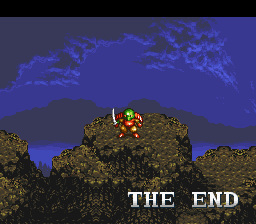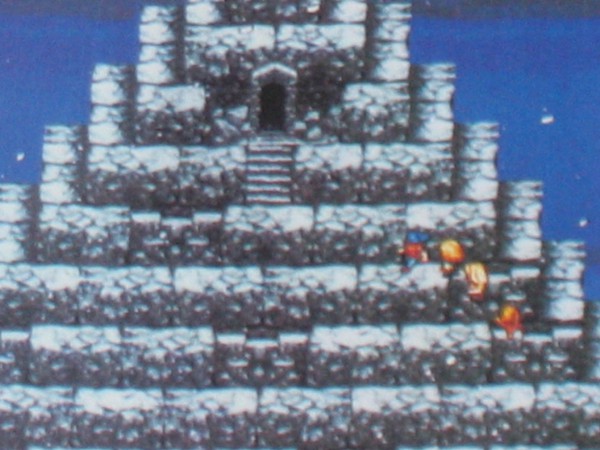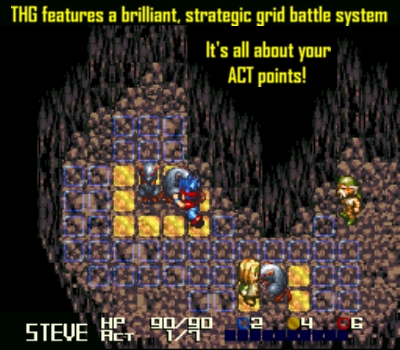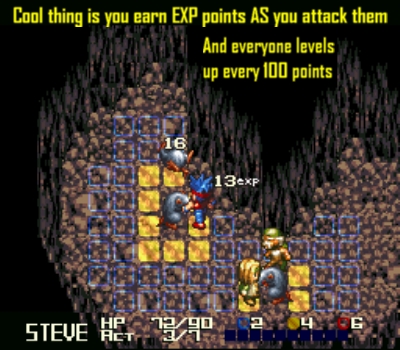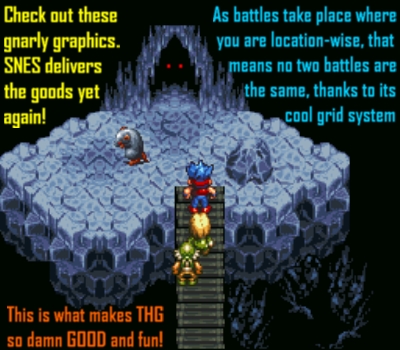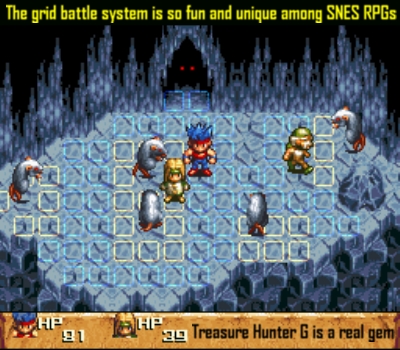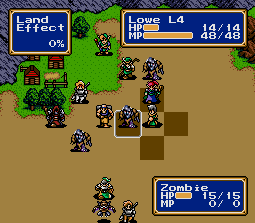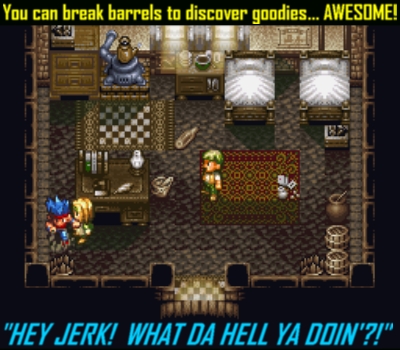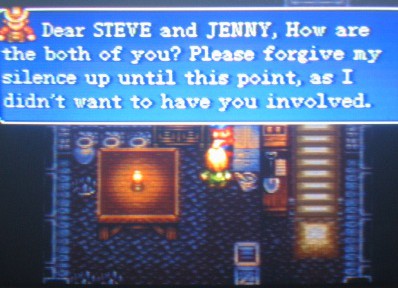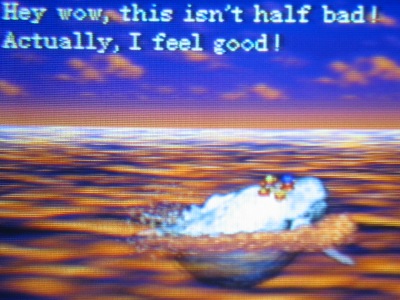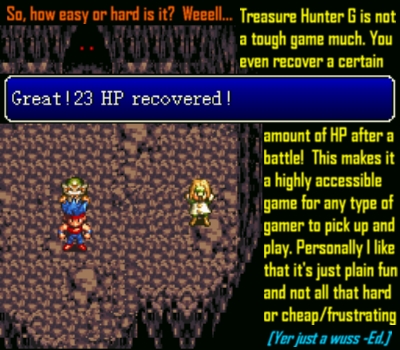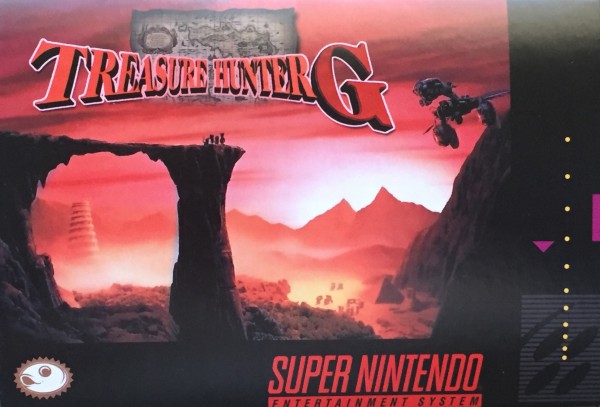
The SNES is blessed to have a stacked library that features some of the finest RPGs from the 16-bit era. Of course you have the good old standbys: Chrono Trigger, EarthBound, Final Fantasy III and so forth. But there are some lesser known RPGs that, while not quite in the same class as the aforementioned titans, are definitely worth your time. Similar to Gunman’s Proof, Treasure Hunter G is a “hidden gem” that doesn’t get nearly enough credit. Thanks to a dedicated community, lost gems like this have been fully translated and are ready to be explored. Ever wake up one morning and find yourself thinking, “Man, if only there were a game where I can save the world using two brothers, a girl and a monkey” — let’s be real here, who hasn’t? Well then, you’re in luck. Enter Treasure Hunter G!
A HIDDEN TREASURE UNEARTHED
Treasure Hunter G was one of those games I never knew about until 2010 or so. I feel it flies under the radar and doesn’t get nearly the recognition it deserves, even in SNES circles. It can sort of be described as Donkey Kong Country meets a strategy RPG. It’s not hard to see why given the pre-rendered graphics and a primate companion. Sadly, by the time this game came out (May 1996), the SNES was pretty much dead in the water here in North America. As such, it was doomed never to touch American soil. Thanks to the dedicated efforts of a gentleman by the fine name of Metalhawk, gamers can now experience “lost” gems like Treasure Hunter G in all its English glory. What I love most about this game is how much you can explore your environment. By comparison it makes searching in other RPGs look downright primitive. If you see it you can smash it. We’re talking jars, pots, barrels, hell, even bushes aren’t safe from your OCD to treasure hunt. This leads to discovering useful items and the like, which make exploring the landscape very rewarding indeed. It’s a blast just to run around, destroying your surroundings and discovering secrets galore.
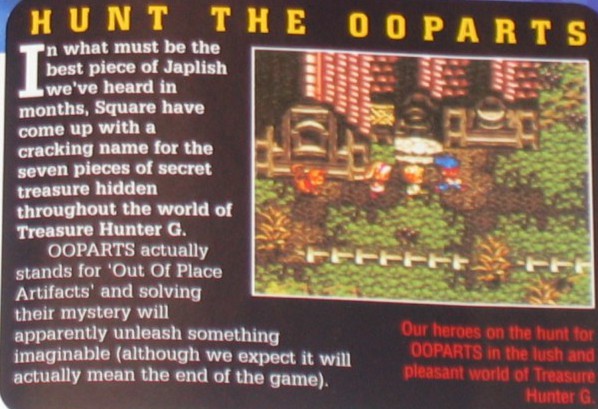
Treasure Hunter G has a charming exploratory feel to it, and it’s only fitting given the title. You’ll traverse many unique locations and bear witness to some truly awe-inspiring sights, all in the good name of treasure hunting. Along the way there are plenty of apoplectic bad guys to dismantle, funky NPCs to interact with and various allies that are certain to leave a lasting impression.
THE STORY GOES…
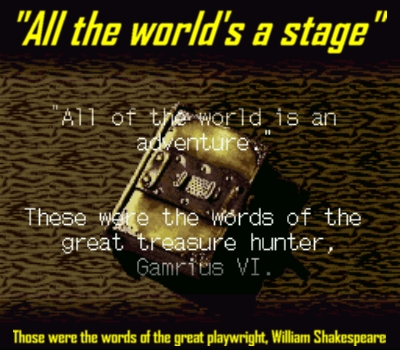
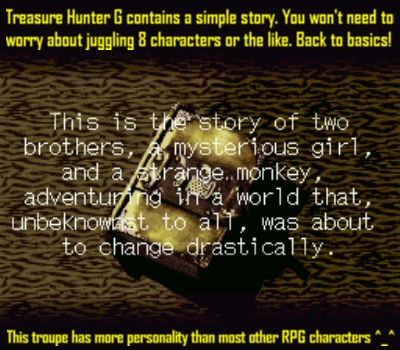
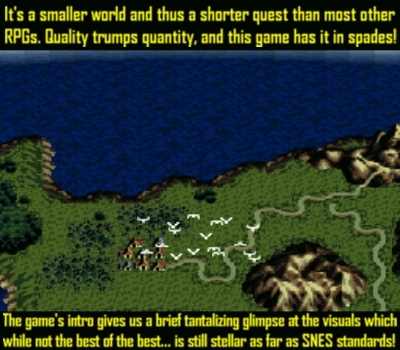
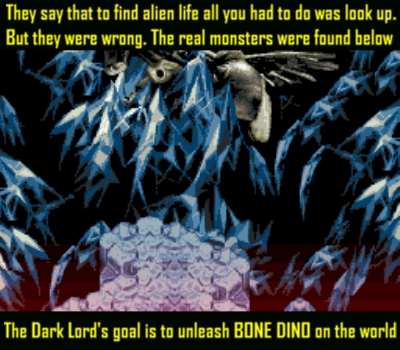

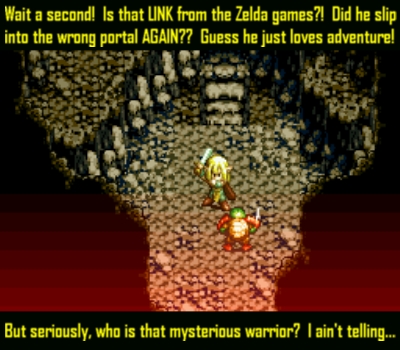
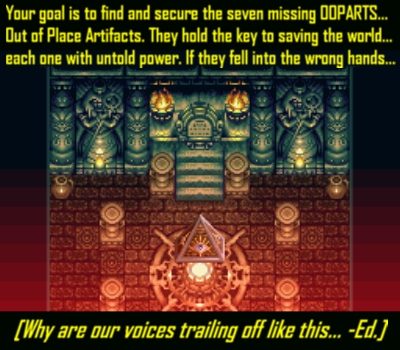

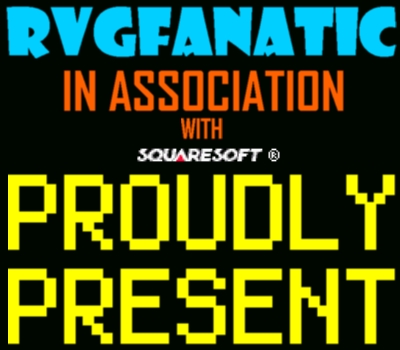
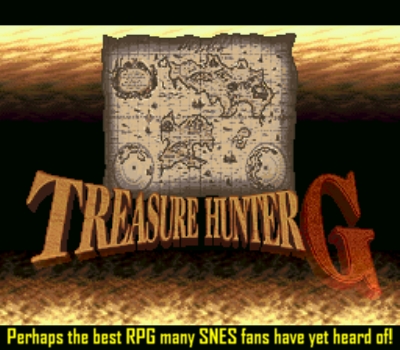
THE HEROES
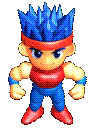 Red is the main protagonist. Not surprisingly, he’s the strongest character in your posse. Although he cannot use long-ranged weapons, he does swing a mean sword. Sadly, his mother passed away when he was young, and his father, Brown G, is often away on his treasure hunting expeditions. Therefore, Red was forced to fend for himself and take care of his younger brother for all those years. Robbed of a robust childhood, Red can be defiant and rebellious. He has the least amount of action points so he doesn’t get around as much as the others, but Red does possess the most evade and health points. Overall, he is a solid and capable combatant.
Red is the main protagonist. Not surprisingly, he’s the strongest character in your posse. Although he cannot use long-ranged weapons, he does swing a mean sword. Sadly, his mother passed away when he was young, and his father, Brown G, is often away on his treasure hunting expeditions. Therefore, Red was forced to fend for himself and take care of his younger brother for all those years. Robbed of a robust childhood, Red can be defiant and rebellious. He has the least amount of action points so he doesn’t get around as much as the others, but Red does possess the most evade and health points. Overall, he is a solid and capable combatant.
 Growing up a latchkey child, Blue has been (pardon the pun) rendered helpless. He is often found crying and whining; it’s safe to say that he’s one of the most feminine male characters in SNES history. However, don’t judge a book by its cover because Blue proves handy in battle. He can effectively wield either an axe or spear, which can strike two squares away and hit up to two bad guys at once. Owning the second highest amount of action and health points, he can set deadly traps as well. Eat your heart out, Kevin McCallister (Macaulay Culkin).
Growing up a latchkey child, Blue has been (pardon the pun) rendered helpless. He is often found crying and whining; it’s safe to say that he’s one of the most feminine male characters in SNES history. However, don’t judge a book by its cover because Blue proves handy in battle. He can effectively wield either an axe or spear, which can strike two squares away and hit up to two bad guys at once. Owning the second highest amount of action and health points, he can set deadly traps as well. Eat your heart out, Kevin McCallister (Macaulay Culkin).
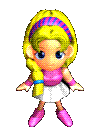 Who is this mysterious girl that goes by the name of Rain? You’re not entirely sure when she shows up but being compassionate (and possibly horny) you take her in all the same. Fulfilling the RPG rule to have at least one female party member, Rain is the kind of gal that trouble can’t help but follow. And surprise surprise, she is the weakest of the group. On the bright side, she has the most action points and she also knows some powerful (healing) spells that are sure to come in handy. She can also communicate with her primate pal. So while she may be physically weak, she contributes in many other ways.
Who is this mysterious girl that goes by the name of Rain? You’re not entirely sure when she shows up but being compassionate (and possibly horny) you take her in all the same. Fulfilling the RPG rule to have at least one female party member, Rain is the kind of gal that trouble can’t help but follow. And surprise surprise, she is the weakest of the group. On the bright side, she has the most action points and she also knows some powerful (healing) spells that are sure to come in handy. She can also communicate with her primate pal. So while she may be physically weak, she contributes in many other ways.
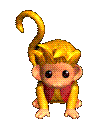 Monkeys. You can’t live with them, you can’t live without them. Or so the saying goes… [There is no such saying, fool -Ed.]. Ponga is a cool little bastard who makes it impossible for you NOT to fall in love with. Able to play the violin and use magic, Ponga is unusually gifted for a monkey. He strikes with cutters which can hit up to two spaces (be careful that you don’t hit your own allies, which YES, you actually can). In addition, he is capable of learning all the spells within the game. Not just here to be a token cute mascot, Ponga is well rounded and will quickly endear himself in your gaming heart.
Monkeys. You can’t live with them, you can’t live without them. Or so the saying goes… [There is no such saying, fool -Ed.]. Ponga is a cool little bastard who makes it impossible for you NOT to fall in love with. Able to play the violin and use magic, Ponga is unusually gifted for a monkey. He strikes with cutters which can hit up to two spaces (be careful that you don’t hit your own allies, which YES, you actually can). In addition, he is capable of learning all the spells within the game. Not just here to be a token cute mascot, Ponga is well rounded and will quickly endear himself in your gaming heart.
THE ART OF WAR
The combat system is unique and different from most other SNES RPGs you’ve played. While it is turn based, that’s where the similarities end. Players operate on a grid that sees every movement count as an action point. Of course, you only have a set number of action points per round. Blue, yellow and red squares represent different point values, making forward thinking and game planning crucial to one’s success. Each color, then, eats up a certain amount of action points. The game thus works your brain a bit as you can’t just pound the attack button over and over again like you can in most RPGs from that era. I love strategically positioning my party in the right squares to maximize my strikes. It makes fighting very fun and much more rewarding than your standard turn based RPG.
Most RPGs don’t allow you to level up (and regain health as a result) mid-battle. Experience points are usually doled out post-battle. Not so here! Each blow successfully landed grants you experience points on the fly. This means you can actually level up in the middle of a fight and regain full health. It’s such an awesome little feature and one of my many favorite things about Treasure Hunter G. Also, you know how in most RPGs the more you level up the more points you need in order to make the next jump? Well, once again, not the case here. Instead, characters level up for every 100 points accumulated. Nice! The game moves along steadily as a result and it never gets old seeing your levels climb rapidly.
Another unique aspect is that the game never shifts to a new battle scene. You fight it out wherever you are. This ensures that each battle will be unique due to the ever shifting landscape. And yes, sometimes the scenery comes into play. Certain weapons allow you to clobber from a couple squares away, saving you precious action points for more strikes and less maneuvering. Brilliant.
There aren’t many tactical strategy RPGs on the SNES, so it’s nice that this not only fills the void but does so with flying colors. You can attack in 8 directions, cast spells, use items, hell, even set booby traps. Crowding a miscreant, or luring one to be blown SKY HIGH by means of a well placed land mine, is immense loads of fun!
Playing Treasure Hunter G hearkens me back to when I first played Shining Force on the Sega Genesis. I immediately found the grid tactical battle style appealing and unique. It felt more rewarding killing bad guys when you actually had to move your way through any given war zone. Shining Force remains a classic that holds up well to this day. If you liked that game then chances are you’ll dig Treasure Hunter G, too.
THE JOURNEY BEGINS…
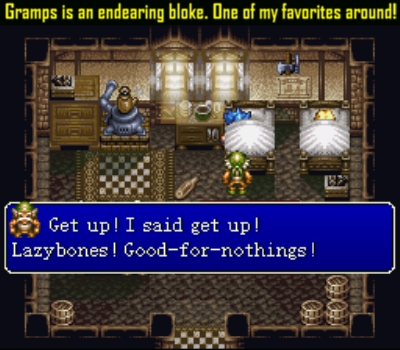
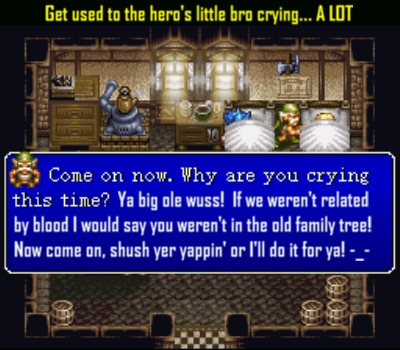

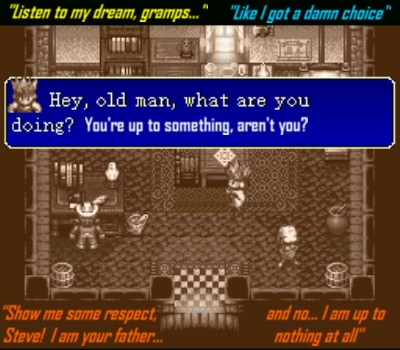

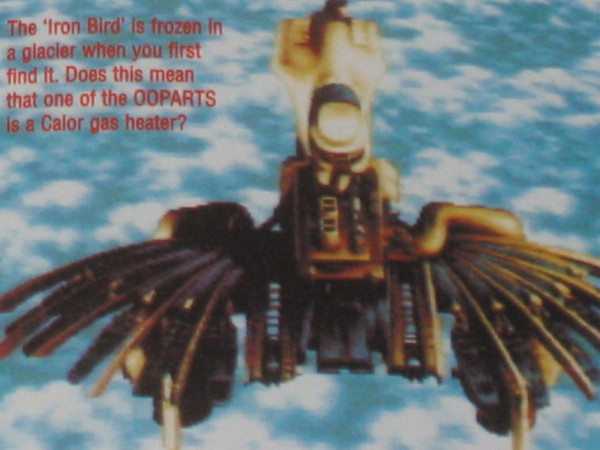
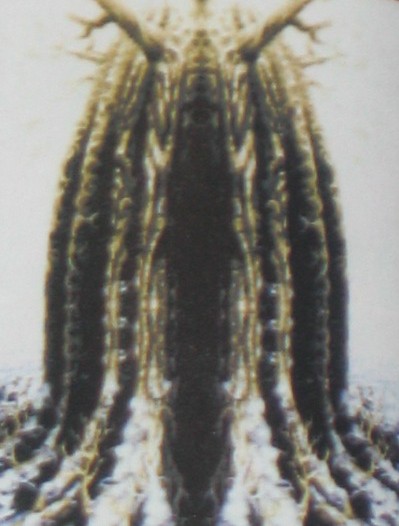
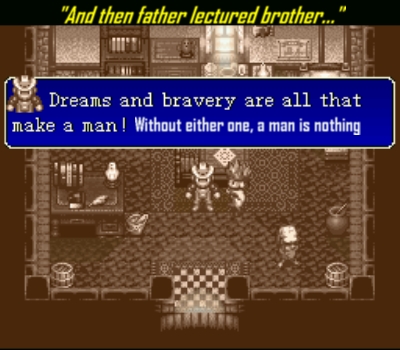
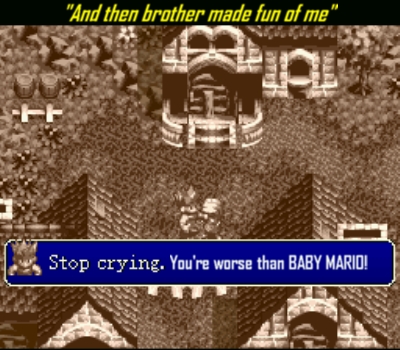
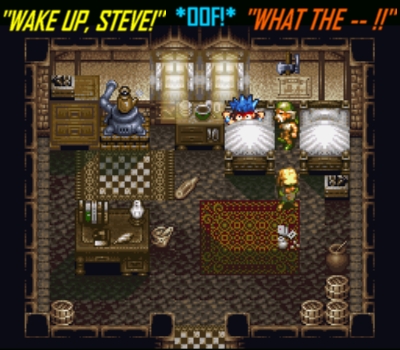

![He's an original (Treasure Hunter) G.. [Oi -Ed.]](http://rvgfanatic.com/wordpress/wp-content/uploads/2017/12/TH-G9.jpg)
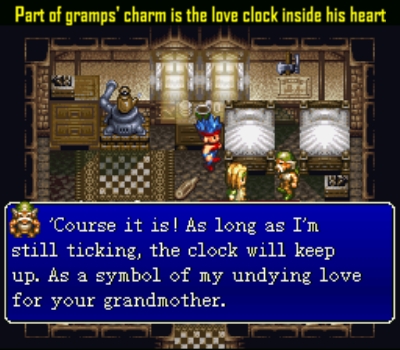

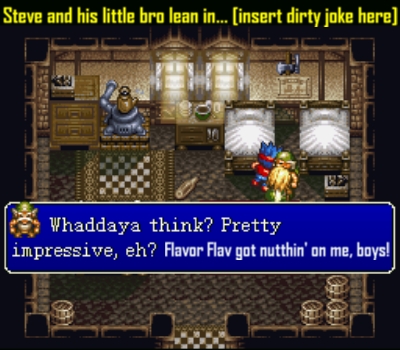
The ability to interact with much of the environment made exploring in this game fun rather than a tedious chore. Some RPGs aren’t very interactive. Treasure Hunter G, on the other hand, lets you can snoop around to your heart’s content!
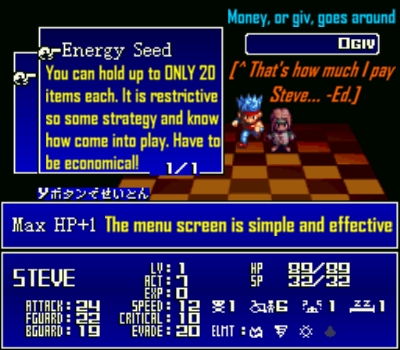

The overhead world map is gorgeous and simple. The map is much smaller than most other SNES RPGs because the game isn’t nearly as long, but I don’t mind that. In fact, one of the reasons I enjoy this game so much is partially due to how quickly it moves along. Pacing is tight and it never wears out its welcome. I can’t say that about all SNES RPGs (*cough* Breath of Fire). Give me quality over quantity!
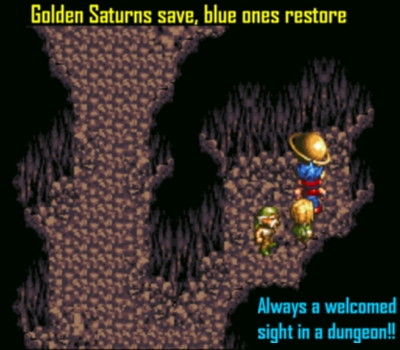
These Saturn statues serve as your classic save or restore points (depending on the color). Nothing beats seeing one of these bad boys after a particularly long and difficult stretch of dungeon crawling.
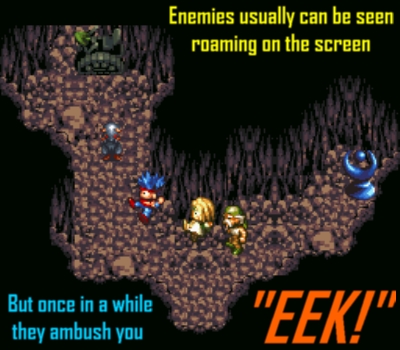
Throughout the existence of RPGs, fans are split on enemy encounters. Should battles occur at random with no warning, or is it best if enemies are visible on screen prior to the battle? Some love the old school random battles but others find it archaic. “Ain’t nobody got time for that!” It’s a bit ironic though if you think about it. It’d be like going to a baseball game and bitching that it isn’t a brisk two hour affair. But I digress. I don’t mind random battles so long as it’s not taking place every few steps. I like being able to see enemies on the field but it does take away a bit of the “suspense,” if you will. Well the good news is that Treasure Hunter G satiates both sides by featuring a bit of both. Though the random battles aren’t random — they’re more like set ambushes, á la Chrono Trigger. On a side note, enemies are eliminated forever once you kill them. Convenient, indeed.
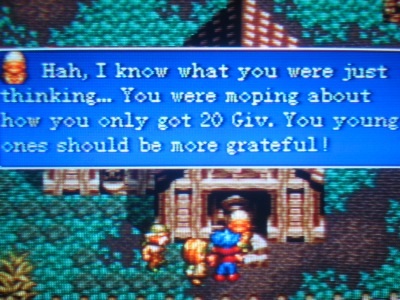

I love everything about the text, from how it looks to the actual words used. It’s just got a very pleasant aesthetic; the font and avatar catches the eye.
Oops, I originally thought Blue was my younger sister hence I I named her Jenny. In reality, Blue is actually my younger brother. Well, it was hard to tell, what with all the crying and long hair! My bad, Blue…
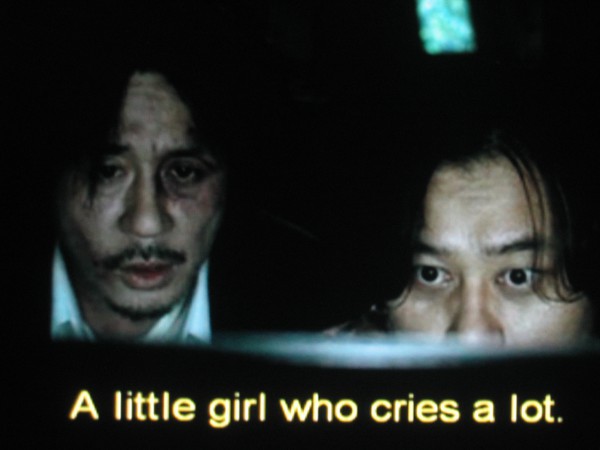
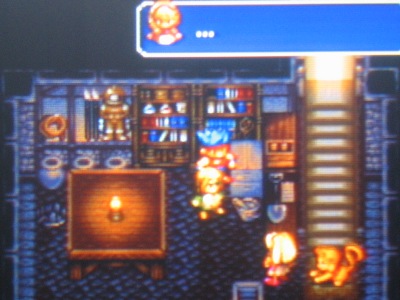
Most RPGs from that era did not allow you to face diagonally. Not so in Treasure Hunter G. It’s the small details, and this game is loaded with them.
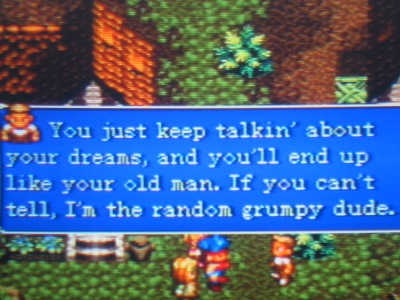
One of my favorite things about RPGs is interacting with all different kinds of NPCs. The NPCs in this game are fun to talk with. Some spew philosophical musings while others lament over their youthful regrets. It’s all handled in a very slick and quirky package that keeps you entertained from start to finish.
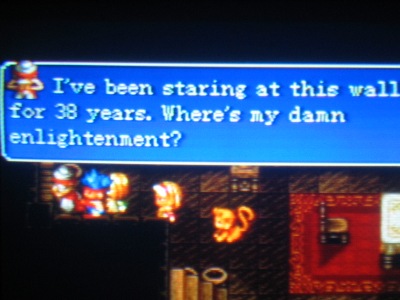
And then there are tongue-in-cheek moments of tomfoolery, showing you that the game never takes itself TOO seriously.
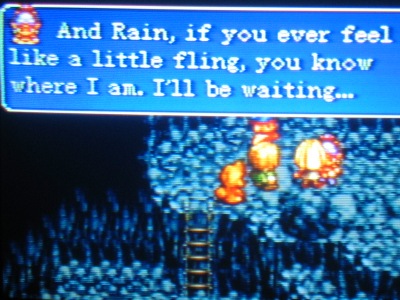
Later you’ll run into a strange little cat named Mio. Mio, ahem, takes a liking to Rain. Talk about something that would never happen in America back in the ’90s.
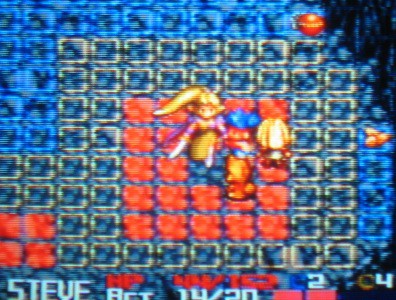
Any RPG worth its weight needs to have some big, bad, memorable bosses to liven things up. Treasure Hunter G has a solid selection on offer, starting with Hel the witch. Hel has an undying loyalty to serve the Dark Lord and she can unleash some nasty spells in addition to teleporting anywhere on the grid. This will keep you on your toes. Kill her zombie minions first, and then go for the head!
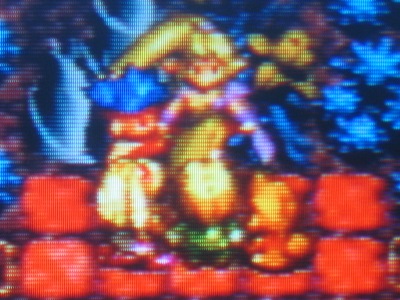
Nothing satisfies like cornering a boss. Take turns teeing off until you pound them into submission. Poor Hel here finds herself trapped, much to the twisted and sick delight of my foul heart.
Who needs Lyft or Uber when you got Kujira the whale? Seeing him streak across that vast ocean with the coalition nestled on top is a sight to behold.
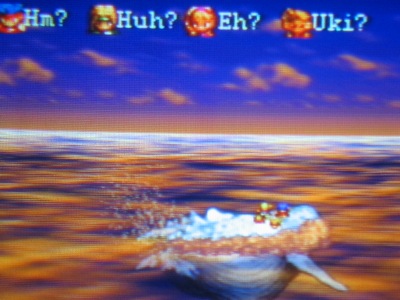
Of course, peace doesn’t last long. Trouble looms over the horizon…
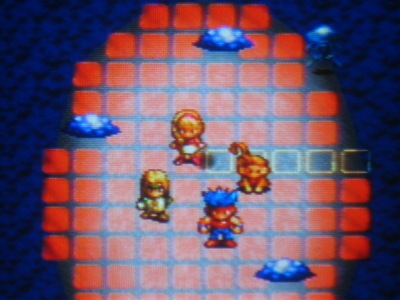
Nothing like playing a game, seeing something cool happen and thinking to yourself, “Man, that’s exactly how I would have programmed it, too!” Using Kujira’s backside as an impromptu war zone? Brilliant.
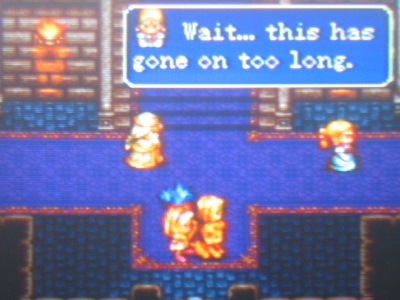
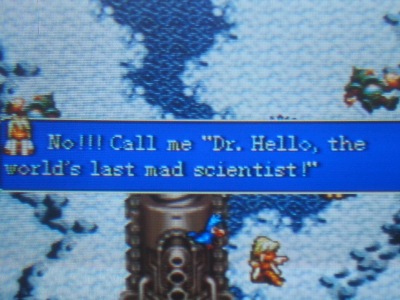
Meet Dr. Hello. He’s the zaniest cat in town, filled to the brim with personality. Not just a pretty face, he also invented some mighty things that will aid you in your quest.

Ah, exactly 20 hours in and it hardly feels like it. That’s when you know a game is doing its job. The pace never dragged; it’s a breath of fresh air when compared to some other RPGs that require 40+ hours to beat.
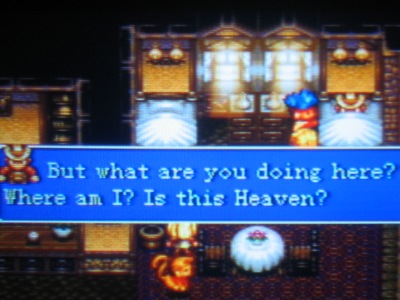
![[D'oh. Someone missed the punchline -Ed.]](http://rvgfanatic.com/wordpress/wp-content/uploads/2017/12/THGEx17.jpg)
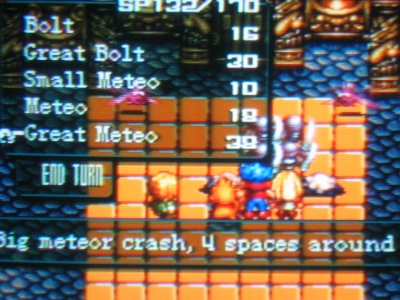

Besides physical attacks, you also have at your disposal a variety of handy spells. These range from pillars of flame to shards of ice. Different spells have different effects, and bigger spells cover more grid tiles. I love it when a spell damages every bad guy in one fell swoop.
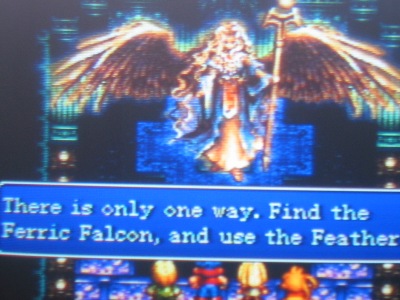
This mammoth winged goddess directs you to the path of serendipity. She is quite the impressive sight, displaying the growth the genre made compared to character models from early SNES RPGs such as Final Fantasy II and Inindo: Way of the Ninja.
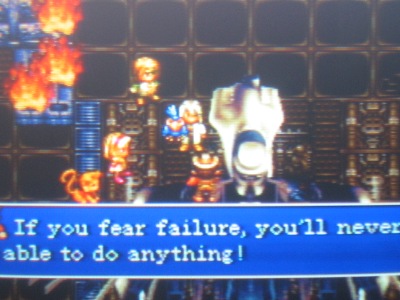
Like that old TV show Father Knows Best, at the end of the day your pops knows what’s up.
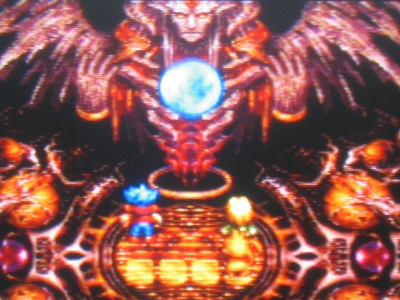
Like most major RPG bosses, the Dark Lord has more than one form. Keep your hero up front because he can only attack up close, and keep Ponga in the back to cast spells.
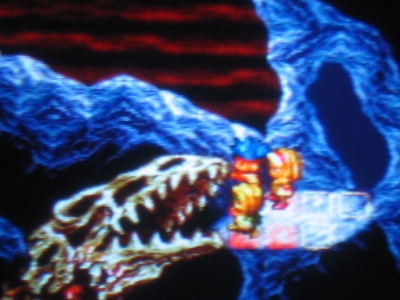
But just when you think it’s over, the Dark Lord’s prized treasure, the Bone Dino, is resurrected! Er, at least partially, anyhow. Still, it makes for quite the spectacle as Dino’s half rotting corpse remains firmly buried in the frozen cliff. With each blow the Bone Dino emits an ear-shattering cry as the screen shakes like a sumbitch, making this final fight very satisfying and memorable. In a weird sort of way, it’s almost a tragic fate for the trapped, half-resurrected monstrosity. Unable to defend itself, you and your party unleash Armageddon on its frozen ass.
G STANDS FOR GRACIOUS
Treasure Hunter G is incredibly easy. You actually recuperate some of your health following each battle. It’s like possessing the Sword of Miracles (for all you Dragon Quest V fanatics out there). But truth be told, I’ll never hate too much on an overly easy game when it’s as much damn fun as this one is.
WHAT THE CRITICS SAID
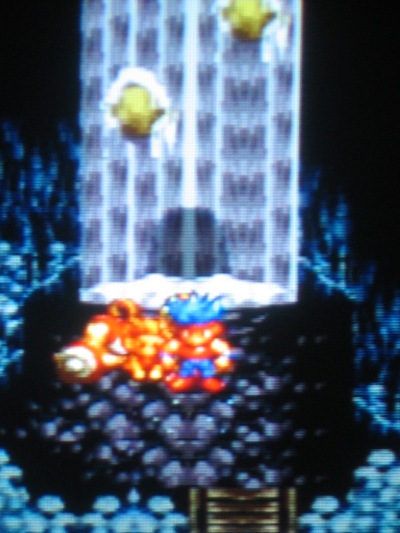
The SNES was left in the dust more or less by mid 1996. Thus, Treasure Hunter G sadly never saw the light of day here in the good old US of A. But suppose for one second that it did. If so, there’s no doubt in my mind that it would be hailed and lionized as one of the better RPGs on the SNES today. In reality though, only dedicated and devoted SNES gamers who scour retro gaming forums and spend hours looking for hidden gems they might have missed, will ever experience all the joys this game has to offer. Although gaming history cannot be rewritten, thankfully the original Japanese dialogue was so that English users can enjoy this game as though it were officially released. And enjoy it they did — I have yet to meet anyone who didn’t like Treasure Hunter G after giving it a shot.
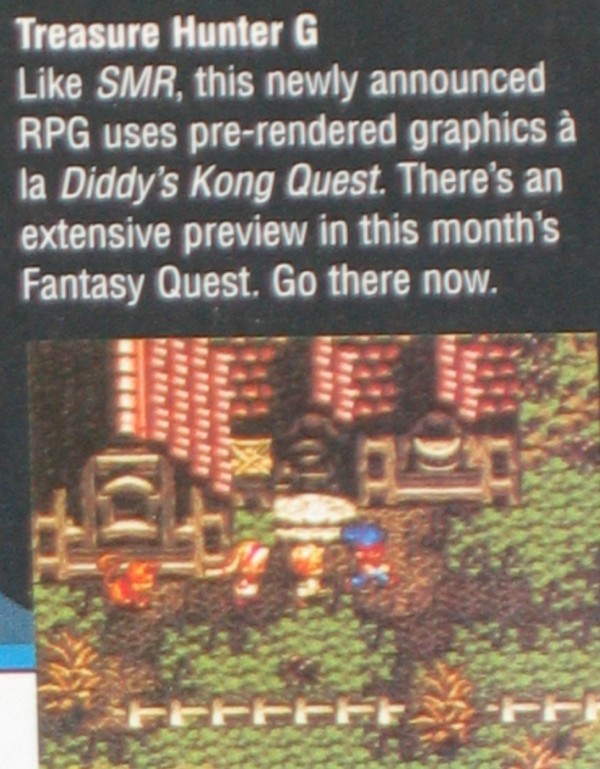
CLOSING THOUGHTS
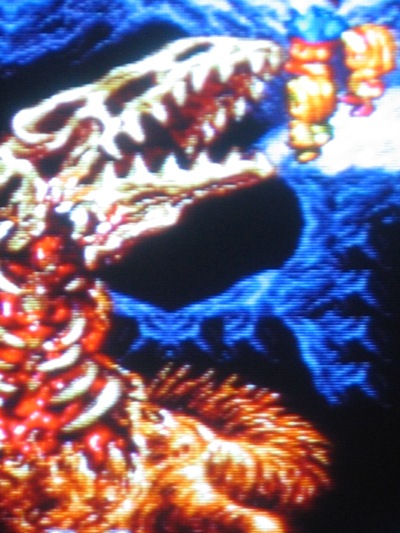
Treasure Hunter G just might be the best SNES RPG you’ve yet to play. It combines cutting edge visuals (for its time) with good old fashioned RPG traits. This includes a simplistic four person party, zero class changes and plenty of fun NPCs to interact with. Add to this a unique grid style battle system and you have something that is truly special. The game looks beautiful and plays like a dream. Every battle is a little different due to the shifting landscapes so there’s more strategy to be found here than your average RPG. The formula works extremely well and makes going through the zany universe a blast. With plenty of rich locales to traverse, nasty bad guys to kill, wacky locals to meet and rare treasures to be found, Treasure Hunter G is a great adventure from beginning to end.
![That's what she said {What is this, 2005? -Ed.]](http://rvgfanatic.com/wordpress/wp-content/uploads/2017/12/THGEx25.jpg)
But of course it’s not without some flaws. You can only carry 20 items per character which can be annoying at times when the goods begin to quickly pile up. On the other hand, this added even more strategy as you’re forced to work out what to keep and what not to. Though developer Sting did a fairly admirable job with the sound and music, it’s not up to par with the likes of Square or Nintendo. The game is also on the easy and short side. But honestly, after playing so many 40+ hour RPGs I found it refreshing to play one that only took me 26 hours and could probably be finished in 20. Rather than dragging on and wearing out its welcome, Treasure Hunter G moves along at a very brisk pace. And by the time you finally imprison Bone Dino in its frozen grave, you almost feel a sense of sorrow that the end is nigh. If you love the genre and the SNES then do yourself a favor and play this game. Besides, I ask you, where else could you save the world with a violin playing monkey? I rest my case. Put this at the top of your queue; you’ll be glad you did. Squaresoft’s last game published on the SNES is not only worthy, it’s a damn fine swan song.
Graphics: 9
Sound: 8
Gameplay: 9
Longevity: 8
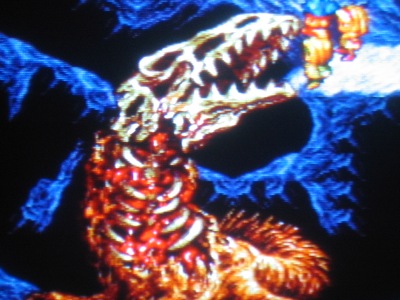
You can’t help but feel a little empathetic for Bone Dino. What did it ever do? The Dark Lord is the true evil one here. He resurrected Bone Dino in the hopes of making the creature do his evil bidding. But the Bone Dino was only halfway resurrected and is basically left defenseless as you pick its bones.
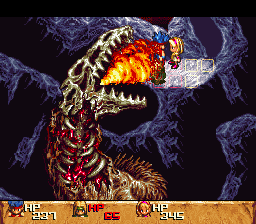
It’s definitely not like any other end boss I can think of on the SNES. Ultimately, Bone Dino was less an abomination of destruction and more an unwilling victim of circumstances. Truly tragic, then.
